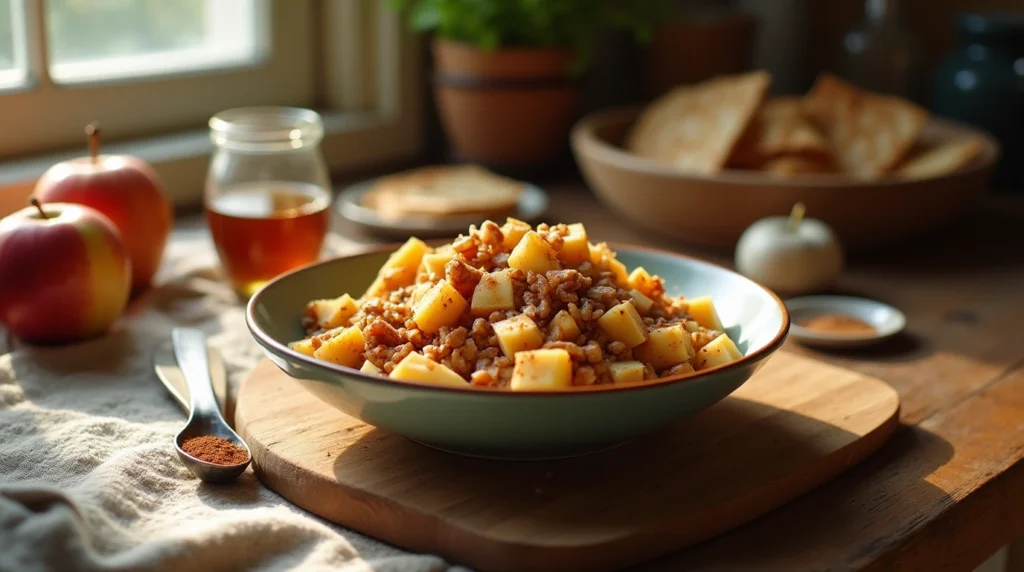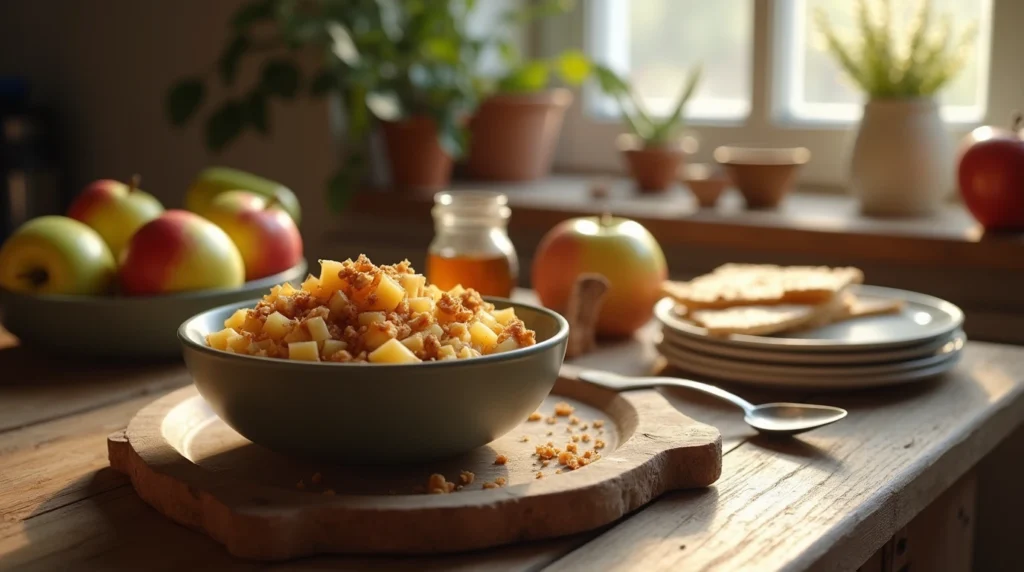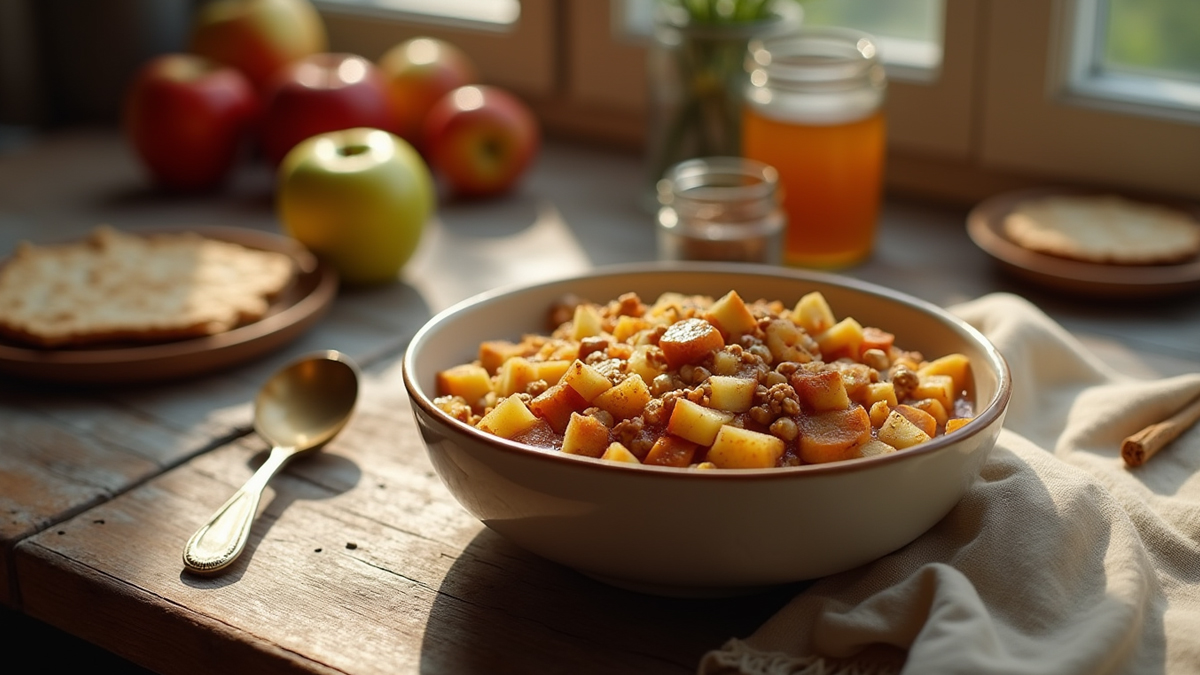If you’re looking for the perfect charoset recipe for your Passover Seder, you’ve come to the right place! Charoset is a sweet, symbolic dish that is traditionally enjoyed during the Jewish festival of Passover. Made from a combination of fruits, nuts, and spices, this dish represents the mortar used by Jewish slaves to build structures in ancient Egypt. Whether you’ve made charoset before or are preparing it for the first time, this comprehensive guide will walk you through the best recipes, variations, and tips for creating the perfect charoset to accompany your Seder meal.
In this article, we’ll explore the history and cultural significance of charoset, share a classic Ashkenazi recipe, and discuss regional variations, healthy alternatives, and helpful tips to ensure you make the most flavorful charoset every time.

What is Charoset?
Charoset is a symbolic food served during the Passover Seder. It typically combines fruits, nuts, spices, and wine. The ingredients come together to represent the mortar used by Jewish slaves in Egypt when they built structures for the Pharaoh.
The classic Ashkenazi version of charoset includes apples, walnuts, cinnamon, and red wine, while Sephardic Jews often add dried fruits such as figs, raisins, and apricots. Charoset plays a central role in the Passover Seder, where we use it to remember the suffering and labor endured by the Israelites during their enslavement in Egypt.
Cultural Significance of Charoset
Charoset symbolizes much more than just a mixture of ingredients. It connects today’s Jewish community with their ancestors who suffered in Egypt. The sweet taste of charoset contrasts with the bitterness of the maror (bitter herbs), reminding us of the resilience of the Jewish people.
To learn about other culturally significant dishes, check out Arlington Chicken Salad, which makes a great addition to any festive meal.
Classic Charoset Recipe (Ashkenazi Style)
This traditional Ashkenazi charoset recipe serves as a great starting point if you’re new to making charoset or if you simply prefer a simple, delicious version.
Ingredients
- 2 large apples (Granny Smith or Gala work best for their balance of sweet and tart)
- 1 cup walnuts (chopped)
- 2-3 tablespoons honey
- 1/2 teaspoon ground cinnamon
- 1/4 cup red wine (or grape juice for a non-alcoholic version)
Instructions
- Prepare the Apples: Peel and core the apples. Then, cut them into small cubes or shred them, depending on your texture preference. Some prefer a finer texture, while others like chunkier pieces in their charoset.
- Chop the Walnuts: Chop the walnuts into small pieces to allow their flavor to blend seamlessly with the apples. You can also use other nuts like pecans or almonds, but walnuts are traditional for Ashkenazi charoset.
- Mix Ingredients: Combine the apples, walnuts, and cinnamon in a large bowl. Stir in the honey, making sure everything is evenly coated. The honey adds natural sweetness, while the cinnamon provides a warm, spicy flavor.
- Add the Wine: Slowly pour in the red wine (or grape juice) to reach your desired consistency. Some prefer a thicker charoset, while others like a looser consistency. Adjust the liquid to your preference.
- Chill and Serve: Refrigerate the charoset for at least 30 minutes to allow the flavors to meld together. Serve chilled during your Passover Seder.
If you love making simple yet flavorful dishes, you might also want to try Arroz Con Pollo. It’s a hearty meal that pairs well with charoset and will surely impress your guests.

Variations of Charoset Across Jewish Communities
While the classic Ashkenazi-style charoset is the most well-known, many variations exist across Jewish communities. Let’s explore some of the most popular versions.
Sephardic Charoset
Sephardic charoset, which comes from Jewish communities in Spain, North Africa, and the Middle East, typically features a sweeter and fruitier combination than the Ashkenazi version. The key ingredients for Sephardic charoset include dried fruits like figs, dates, raisins, and apricots, mixed with almonds and wine or brandy.
Ingredients for Sephardic Charoset:
- 1 cup dates (chopped)
- 1/2 cup figs (chopped)
- 1/4 cup raisins
- 1/4 cup apricots (chopped)
- 1/2 cup almonds (sliced or chopped)
- 2 tablespoons honey
- 1/4 cup sweet red wine (or brandy)
Instructions:
- Combine all of the dried fruits in a large bowl.
- Add the almonds, honey, and red wine, and mix well until all the ingredients are evenly coated.
- Allow the mixture to sit in the refrigerator for a few hours to blend the flavors.
This version of charoset is perfect for those who enjoy a fruity and nutty taste.
For more international dishes, consider trying Carne Guisada. It’s a savory treat that complements charoset well.
Healthy Charoset Variations
Charoset is naturally healthy since it’s packed with fruits and nuts. However, if you want to make it even healthier, here are some variations:
Reducing Sugar
Instead of honey, try using agave nectar or maple syrup to lower the sugar content. These alternatives are sweet but lower on the glycemic index, making them suitable for those managing blood sugar levels.
Nut-Free Option
If you have allergies or prefer a nut-free version, replace the nuts with seeds, such as sunflower or pumpkin seeds. These will provide a similar texture while keeping the dish allergy-friendly.
For an alternative dessert that’s equally healthy, try Cinnamon Rolls. They’re both sweet and satisfying without overwhelming the senses.
Tips for Making Perfect Charoset
Making charoset may seem simple, but a few tips will help ensure that you get the best results:
- Choose Fresh Ingredients: The quality of the apples and walnuts will impact the overall flavor. Fresh, crisp apples and high-quality nuts will give your charoset a better taste and texture.
- Balance Sweet and Spicy: Balance the sweetness of the honey with the warmth of the cinnamon. Taste as you go and adjust the seasonings to suit your preferences.
- Refrigerate: Let your charoset sit in the fridge for at least 30 minutes to allow the flavors to meld together, creating a harmonious dish.
- Storage: Charoset can be made ahead of time and stored in an airtight container in the fridge for up to 3 days.
If you need more tips on meal preparation, check out this guide on Making Burnt Ends at Home. It’s a delicious and easy-to-follow recipe for a flavorful main dish.

Serving Suggestions for Charoset
Charoset is traditionally served at the Passover Seder as part of the symbolic foods on the Seder plate. It is eaten with matzo and sometimes with bitter herbs to represent the hardships of slavery. However, charoset can be enjoyed in many other ways:
- On Sandwiches: Spread charoset on matzo or any type of bread for a sweet snack.
- As a Topping: Use charoset as a topping for yogurt or even ice cream.
- Pair with Cheese: The sweet and nutty flavors of charoset pair wonderfully with cheese, making it a great addition to a cheese platter.
You can also enjoy it alongside Blueberry Bread for a unique, sweet combination.
Common Mistakes When Making Charoset
While making charoset is straightforward, watch out for these common mistakes:
- Using Too Many Nuts: A little goes a long way. Too many walnuts or almonds can overpower the sweetness of the apples.
- Not Balancing the Flavors: Balance the sweetness with a hint of spice. Adjust the cinnamon or wine to suit your taste.
- Not Chilling: Charoset tastes best after it has had time to chill and let the flavors meld together. Don’t skip this step!
FAQs About Charoset
Can I make charoset ahead of time?
Yes, charoset can be made ahead of time and stored in an airtight container in the fridge for up to 3 days. The flavors will improve as they sit.
What can I use instead of wine in charoset?
If you prefer not to use wine, substitute grape juice or apple juice. It will still give you the sweetness and balance without the alcohol.
Can charoset be frozen?
Charoset is best served fresh, but if you have leftovers, store it in the freezer for up to a month. Thaw it in the refrigerator before serving.
By following this guide, you’ll be able to create a delicious and meaningful charoset that adds both flavor and tradition to your Passover Seder. Whether you stick with the classic Ashkenazi style or try something new, charoset is a versatile dish that can be enjoyed in many ways.
If you’re looking for a hearty meal to serve alongside your charoset, try making Caldo de Res, a flavorful Mexican beef soup that complements the sweetness of charoset.
Print
Charoset Recipe: A Complete Guide to the Sweet Tradition of Passover
- Total Time: 25 minutes
- Yield: 8 servings 1x
- Diet: Vegan
Description
This comprehensive guide to charoset recipes offers step-by-step instructions for making the perfect sweet dish for your Passover Seder. Explore traditional and creative variations, learn about the cultural significance of charoset, and discover helpful tips to elevate your holiday meal.
Ingredients
Ingredients for Classic Ashkenazi Charoset:
- 2 large apples (Granny Smith or Gala work best)
- 1 cup walnuts (chopped)
- 2–3 tablespoons honey
- 1/2 teaspoon ground cinnamon
- 1/4 cup red wine (or grape juice for a non-alcoholic version)
For Sephardic Charoset, you can try the following ingredients:
- 1 cup dates (chopped)
- 1/2 cup figs (chopped)
- 1/4 cup raisins
- 1/4 cup apricots (chopped)
- 1/2 cup almonds (sliced or chopped)
- 2 tablespoons honey
- 1/4 cup sweet red wine (or brandy)
Instructions
Instructions for Classic Ashkenazi Charoset:
- Prepare the Apples:
Peel and core the apples. Cut them into small cubes or shred them, depending on your texture preference. For a smoother charoset, you can shred the apples. For a chunkier version, cut them into small cubes. - Chop the Walnuts:
Chop the walnuts into small pieces. Be careful not to chop them too finely; you want some texture to balance with the apples. - Mix Ingredients:
In a large mixing bowl, combine the chopped apples, walnuts, and ground cinnamon. Stir the mixture gently to distribute the cinnamon evenly throughout. - Add Honey:
Pour in 2-3 tablespoons of honey, depending on how sweet you want your charoset. Stir everything together until the apples and walnuts are evenly coated with the honey. - Add Wine:
Slowly pour in 1/4 cup of red wine (or grape juice if you prefer a non-alcoholic version). Stir the mixture again, adjusting the consistency to your liking. If you prefer a thicker charoset, use less wine; for a looser mixture, add more. - Chill and Serve:
Cover the bowl and refrigerate the charoset for at least 30 minutes. This allows the flavors to meld together. Charoset is traditionally served cold, and the longer it sits, the better the flavors will develop.
Instructions for Sephardic Charoset:
- Prepare the Dried Fruits:
Chop the dates, figs, apricots, and raisins into small pieces. You want these to be in bite-sized pieces so they mix well with the other ingredients. - Chop the Almonds:
Slice or chop the almonds into small pieces. If you prefer a smoother charoset, you can also use ground almonds. - Combine Ingredients:
In a large bowl, mix the chopped dried fruits, almonds, and ground cinnamon. Stir gently to distribute the cinnamon evenly. - Add Honey:
Pour in 2 tablespoons of honey and mix until the fruits and nuts are well-coated. The honey adds sweetness and helps bind the ingredients together. - Add Wine:
Pour in 1/4 cup of sweet red wine (or brandy if you want a more robust flavor). Stir everything together to achieve your desired consistency. Adjust the wine amount depending on how thick or runny you want your charoset. - Refrigerate:
Cover the bowl and refrigerate the charoset for at least 2 hours (or overnight) for the best flavor. The longer it sits, the more the flavors blend.
Notes
- Customize Sweetness:
Feel free to adjust the sweetness of the charoset by adding more or less honey, depending on your preference. If you prefer a sweeter charoset, you can add additional honey or even a little bit of maple syrup. - Consistency Adjustment:
The consistency of charoset can vary depending on how finely you chop the fruits and nuts. If you like a smoother texture, shred the apples and chop the walnuts finely. For a chunkier charoset, simply chop the apples and nuts into larger pieces. - Wine Substitutes:
If you prefer not to use wine, grape juice or apple juice is an excellent alternative. The wine adds a depth of flavor, but the charoset will still be delicious without it. For a non-alcoholic version, simply use grape juice and ensure that it’s a sweet variety. - Other Nut Options:
While walnuts are traditional in Ashkenazi charoset, you can experiment with other nuts, such as pecans, almonds, or hazelnuts. Each nut brings a slightly different flavor to the charoset. - Store in the Fridge:
Charoset can be made in advance and stored in an airtight container in the fridge for up to 5 days. The flavors tend to improve as it sits, so preparing it the day before serving is often a good idea. - Serve with Matzo:
Charoset is traditionally eaten with matzo during the Passover Seder. You can also serve it as a topping for challah bread or as part of a Passover meal spread. - Try a Variety:
Don’t be afraid to get creative! While Ashkenazi and Sephardic charoset are the most common, you can experiment with different fruits and nuts. Dried apricots, figs, raisins, or even pomegranate seeds can be added to create unique variations. - Add Spices:
Cinnamon is a key spice in charoset, but you can also add a pinch of nutmeg, allspice, or even a bit of ginger to enhance the flavor. Adjust the spices to suit your taste. - Vegan Option:
The classic charoset recipe is naturally vegan, but make sure to check your wine or grape juice to ensure it’s vegan-friendly (some wines are clarified using animal products).
By keeping these notes in mind, you’ll be able to create a charoset that perfectly suits your taste and adds an extra touch of tradition to your Passover celebration.
- Prep Time: 25 minutes
- Category: Passover Recipes
- Cuisine: Jewish Cuisine
Nutrition
- Serving Size: 1 Serving
- Calories: 180-200 kcal
- Sugar: 18g
- Sodium: 1mg
- Fat: 8g
- Saturated Fat: 1g
- Carbohydrates: 30g
- Fiber: 4g
- Protein: 2g
Keywords: charoset recipe, Passover recipe, Jewish recipes, charoset for Seder, traditional charoset, sweet Passover dishes, holiday recipes, charoset variations, Sephardic charoset, Ashkenazi charoset, matzo charoset, best charoset recipe, Passover desserts, charoset ingredients, charoset history, charoset tips, homemade charoset

